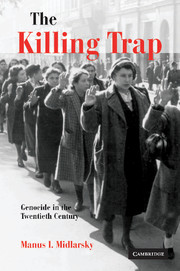Book contents
18 - Findings, consequences, and prevention
Published online by Cambridge University Press: 22 September 2009
Summary
The twentieth century witnessed the horrors of genocide and its sequelae, horrors that unfortunately have not yet ceased. A major purpose of this volume has been to identify antecedent factors that make genocide more or less likely to occur, as well as factors that increase victim vulnerability, thereby augmenting the magnitude of the killing. In this chapter, therefore, I begin by summarizing similarities and differences in the findings. Following this presentation, I include summaries of the analyses that help clarify the consequences of genocide and modes of genocide prevention including the role of democracy. If nothing else, an investigation of genocide should lead not only to an understanding of its origins and consequences, but also to ways of preventing genocide in the future. Which variables are most likely to signal the onset of genocide and how should interested parties (in the best-case scenario, the entire international community) react?
Similarities and differences
Genocide and other crimes against humanity such as ethnic cleansing share certain features in common. Most important, they are more likely to occur during wartime than during peacetime. War is associated with uncertainty, as its outcome tends to be uncertain. Given the tendency of uncertainty to increase reliance on prior knowledge or memory, as the Bayesian findings inform us, a recent history of loss looms large in its decision-making influence. Loss builds on and coalesces the tendencies toward extremism already inherent in the search for unity and continuity of mass murder.
- Type
- Chapter
- Information
- The Killing TrapGenocide in the Twentieth Century, pp. 369 - 395Publisher: Cambridge University PressPrint publication year: 2005



